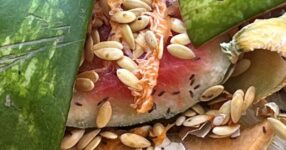It’s late August, and battles are raging in gardens across the Yakima Valley. Whether it’s an incursion of yellow jackets, spotted spurge or crab grass, gardeners are on high alert.
I know they’re relatively harmless and just another annoying fact of life for anyone with a garden or backyard orchard, but I still cannot abide fruit flies.
The fruit flies in my kitchen are the same ones scientists use to study genetics. Drosophila melanogaster make ideal laboratory subjects because they breed prolifically during their short life span.
In your home, fruit flies can be a problem any time of the year. Leave a glass with a splash of red wine on the counter in the dead of winter and eventually a few fruit flies will find it. In late summer and throughout the fall, their numbers peak exponentially due to the availability of decaying fruit and other organic materials.
Being “The Fruit Bowl of the Nation” has some drawbacks.
Fruit flies may be small enough to pass through window screens. Once inside, they congregate around the bowl of freshly harvested fruit you proudly displayed on the kitchen counter.
I’ve been roasting trays of ripe garden tomatoes, and swarms of fruit flies, drawn by the rich aroma, seem to slip into the kitchen each time I open the door.
They’re also attracted to the flowers I arrange in vases of water, and sunflowers seem to be a favorite.
Out on the compost pile, a single adult female can lay up to 500 eggs inside rotting produce. Larvae emerge within 30 hours, feed on yeast found in the fermenting liquid, and grow to adults in just a few days.
When I first notice a kitchen infestation, I use my vacuum hose and suck up as many adults as I can. My kitchen cabinets are painted white and offer no camouflage to the marauders. Doing this several times each hour really does decrease the number of flies and gives me a great sense of satisfaction. If I don’t empty the dust container frequently, my vacuum cleaner could turn into a breeding ground for new generations of flies.
The bad news is that the adults I see flying around the kitchen have likely laid eggs. Killing the adults makes me feel better but has little impact on the potential future population. Eliminating the fruit sources and frequent sanitation to kill the eggs are the best ways to keep their numbers down.
Keep their lids on tight and empty all trash containers regularly. Clean and rinse them to make sure no residue remains that could attract more flies.
Check your pantry. I’ve found that a single rotting potato or onion is all it takes to attract fruit flies.
While you’re at it, if your recycling bins are inside, check them. The sweet liquid residue inside soda and beer cans and wine bottles is especially alluring to fruit flies.
Until cold weather arrives, my house rule is that all fresh produce must be rinsed and refrigerated as soon as it enters the kitchen. I don’t refrigerate tomatoes, but if they come inside, they must be stored in containers with airtight lids.
We collect kitchen waste for composting in a 1-gallon lidded bucket on the kitchen counter. This time of year, the bucket remains outside and away from the entrance to our home. It’s inconvenient, but it helps.
Keep the sink and garbage disposal clean and sanitized. Fruit flies love sink drains where food residue may build up.
Moist dish rags and kitchen sponges are fruit fly magnets where they love to breed. Manage them accordingly.
In combination with these sanitation steps, these two fruit fly trap designs are recommended by Michigan State University Extension:
• Use a small jar with a homemade paper cone set on top with the narrow end of the cone pointing down. Place a small amount of juice, wine or overripe fruit in the bottom to attract the flies. The cone will keep them in the jar until they die. Empty the jar and replace the lure every day.
• Fill several small juice glasses with apple cider vinegar to about 2/3 full. Add a drop or two of liquid dishwashing soap and swirl to mix. Tightly stretch plastic wrap across the top of the glasses and hold it in place with a rubber band. Punch a dozen holes in the plastic with a toothpick and set the traps wherever fruit flies seem to be congregating. The flies enter the trap through the holes and drown in the vinegar.
You may be able to catch more bears with honey than vinegar, but vinegar works for fruit flies.
• Carol Barany and her husband, John, found paradise on 1 1/3 acres just west of Franklin Park, where they raised three children and became Master Gardeners. Contact her at florabundance14@gmail.com.




